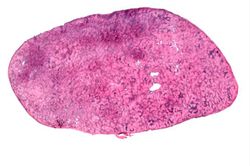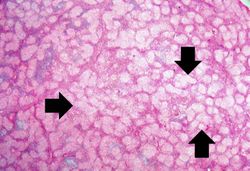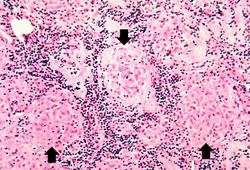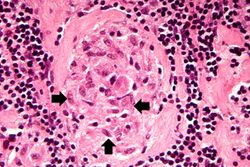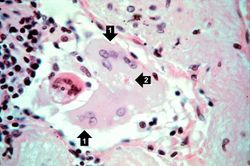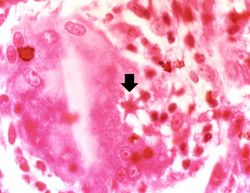Difference between revisions of "IPLab:Lab 3:Sarcoidosis"
Seung Park (talk | contribs) |
Seung Park (talk | contribs) |
||
| Line 11: | Line 11: | ||
File:IPLab3Sarcoidosis6.jpg|This is a higher-power photomicrograph of an asteroid body (arrow) inside of a multinucleated giant cell. | File:IPLab3Sarcoidosis6.jpg|This is a higher-power photomicrograph of an asteroid body (arrow) inside of a multinucleated giant cell. | ||
</gallery> | </gallery> | ||
| + | |||
| + | Study Questions | ||
| + | |||
| + | * <spoiler text="What is sarcoidosis?">The exact cause of sarcoidosis is unknown. Sarcoidosis is characterized by non-caseating granulomas in many tissues and organs.</spoiler> | ||
| + | * <spoiler text="What is the characteristic phenotype of sarcoid granulomas?">The typical characteristic of a sarcoid granuloma is a non-caseating granuloma which consists of an aggregate of tightly-clustered epitheliod cells, often with Langhans’ or multinucleated giant cells. Occasionally, asteroid bodies may be seen.</spoiler> | ||
| + | * <spoiler text="What are asteroid bodies and are they pathognomonic for sarcoid or are they seen in other diseases?">Asteroid bodies are stellate inclusions within giant cells. They are not pathognomonic for sarcoid; they can be seen in other granulomatous disease processes (e.g., berylliosis).</spoiler> | ||
{{IPLab 3}} | {{IPLab 3}} | ||
Revision as of 04:53, 19 August 2013
Clinical Summary[edit]
This 33-year-old white female was admitted for evaluation of abnormal findings on a chest x-ray. She was asymptomatic and a physical examination revealed no significant abnormalities. Laboratory results indicated hypercalcemia and elevated gamma globulin. Radiographic examination showed enlarged subcarinal, hilar, and right paratracheal lymph nodes. A right paratracheal lymph node was biopsied. Special stains for acid-fast bacilli and fungi were negative and a diagnosis of sarcoidosis was made.
Images[edit]
This is a photomicrograph of the small nodules (arrows) seen in the previous image. Close examination reveals that they are composed of large macrophages (epithelioid macrophages). These small granulomas form multiple series of reaction centers throughout the lymph node. Note the remaining lymphocytes surrounding the granulomas.
Study Questions
Hypercalcemia is the state of having increased levels of calcium in the blood.
